Modification of the Human Amniotic Membrane Using Different Cross-Linking Agents as a Promising Tool for Regenerative Medicine
Abstract
:1. Introduction
2. Materials and Methods
2.1. Materials
2.2. FTIR-ATR Spectroscopy
2.3. Thermal Analysis—TG
2.4. Mechanical Properties
2.5. Enzymatic Degradation
2.6. Biological Research
3. Results
3.1. ATR-FTIR
3.2. Thermal Stability
3.3. Mechanical Properties
3.4. Degradation
3.5. Biological Research
4. Discussion
5. Conclusions
Author Contributions
Funding
Institutional Review Board Statement
Informed Consent Statement
Data Availability Statement
Conflicts of Interest
References
- Zhang, X.; Chen, X.; Hong, H.; Hu, R.; Liu, J.; Liu, C. Decellularized extracellular matrix scaffolds: Recent trends and emerging strategies in tissue engineering. Bioact. Mater. 2021, 10, 15–31. [Google Scholar] [CrossRef] [PubMed]
- Li, J.; Chen, X.; Hu, M.; Wei, J.; Nie, M.; Chen, J.; Liu, X. The application of composite scaffold materials based on decellularized vascular matrix in tissue engineering: A review. BioMed. Eng. Online 2023, 62, 22. [Google Scholar] [CrossRef] [PubMed]
- Mamede, A.C.; Carvalho, M.J.; Abrantes, A.M.; Laranjo, M.; Maia, C.J.; Botelho, M.F. Amniotic membrane: From structure and functions to clinical applications. Cell. Tissue Res. 2012, 349, 447–458. [Google Scholar] [CrossRef]
- Ma, D.H.; Lai, J.Y.; Cheng, H.Y.; Tsai, C.C.; Yeh, L.K. Carbodiimide cross-linked amniotic membranes for cultivation of limbal epithelial cells. Biomaterials 2010, 31, 6647–6658. [Google Scholar] [CrossRef] [PubMed]
- Shortt, A.J.; Secker, G.A.; Lomas, R.J.; Wilshaw, S.P.; Kearney, J.N.; Tuft, S.J.; Daniels, J.T. The effect of amniotic membrane preparation method on its ability to serve as a substrate for the ex-vivo expansion of limbal epithelial cells. Biomaterials 2009, 30, 1056–1065. [Google Scholar] [CrossRef]
- Insausti, C.L.; Blanquer, M.; Bleda, P.; Iniesta, P.; Majado, M.J.; Castellanos, G.; Moraleda, J.M. The amniotic membrane as a source of stem cells. Histol. Histopathol. 2010, 25, 91–98. [Google Scholar]
- Francisco, C.J.; Cunha, R.C.; Simeoni, R.B.; Guarita-Souza, L.C.; Ferreira, R.J.; Irioda, A.C.; Souza, C.M.; Srikanth, G.V.N.; Nityanand, S.; Chachques, J.C.; et al. Amniotic membrane as a potent source of stem cells and a matrix for engineering heart tissue. J. Biomed. Sci. Eng. 2013, 6, 1178–1185. [Google Scholar] [CrossRef]
- Lai, J.Y.; Hui-Kang Ma, D. Glutaraldehyde cross-linking of amniotic membranes affects their nanofibrous structures and limbal epithelial cell culture characteristics. Intl. J. Nanomed. 2013, 8, 4157–4168. [Google Scholar] [CrossRef]
- Niknejad, H.; Peirovi, H.; Jorjani, M.; Ahmadiani, M.; Ghanavi, J.; Seifalian, A.M. Properties of the amniotic membrane for potential use in tissue engineering. Eur. Cells Mater. J. 2008, 15, 88–99. [Google Scholar] [CrossRef]
- Fitriani, N.; Wilar, G.; Narsa, A.C.; Mohammed, A.F.; Takahiro, N.W. Application of Amniotic Membrane in Skin Regeneration. Pharmace 2023, 15, 748. [Google Scholar] [CrossRef]
- Kitagawa, K.; Okabe, M.; Yanagisawa, S.; Zhang, X.Y.; Nikaido, T.; Hayashi, A. Use of a hyperdried cross-linked amniotic membrane as initial therapy for corneal perforations. Jpn. J. Ophthalmol. 2011, 55, 16–21. [Google Scholar] [CrossRef]
- Fujisato, T.; Tomihata, K.; Tabata, Y.; Iwamoto, Y.; Burczak, K.; Ikada, Y. Cross-linking of amniotic membranes. J. Biomater. Sci. Polym. Ed. 1999, 10, 1171–1181. [Google Scholar] [CrossRef] [PubMed]
- Adamowicz, J.; Pokrywczyńska, M.; Tworkiewicz, J.; Kowalczyk, T.; Van Breda, V.S.; Tyloch, D.; Kloskowski, T.; Bodnar, M.; Skopinska-Wisniewska, J.; Marszałek, A.; et al. New amniotic membrane based biocomposite for future application in reconstructive urology. PLoS ONE 2016, 11, e0146012. [Google Scholar] [CrossRef] [PubMed]
- Spoerl, E.; Wollensak, G.; Reber, F.; Pillunat, L. Cross-linking of human amniotic membrane by glutaraldehyde. Ophthalmic Res. 2004, 36, 71–77. [Google Scholar] [CrossRef] [PubMed]
- Arrizabalaga, J.H.; Nollert, M.U. Riboflavin-UVA crosslinking of amniotic membranes and its influence on the culture of adipose-derived stem cells. J. Mech. Behav. Biomed. Mater. 2020, 106, 103729. [Google Scholar] [CrossRef] [PubMed]
- Sekar, K.; Sasirekha, S.; Krishnakumar, T.P.; Sastry, A. Novel cross-linked human amniotic membrane for corneal implantations. Proc. Inst. Mech. Eng. Part H J. Eng. Med. 2012, 227, 221–228. [Google Scholar] [CrossRef]
- Sastry, T.P.; Pandaranga Rao, K. Chemically modified collagenous amniotic layer as wound dressing material. In High Performance Biomaterials, 1st ed.; Szycher, M., Ed.; Technomic Publishing Co.: Basel, Switzerland, 1991. [Google Scholar]
- Skopinska-Wisniewska, J.; Bajek, A.; Maj, M.; Sionkowska, A. PEG-dialdehyde—The new cross-linking agent for collagen/elastin hydrogels. Polym. Advan. Technol. 2017, 28, 763–767. [Google Scholar] [CrossRef]
- Skopinska-Wisniewska, J.; Wegrzynowska, K.; Bajek, A.; Maj, M.; Sionkowska, A. Is dialdehyde starch a valuable cross-linking agent for collagen/elastin based materials? J. Mater. Sci.-Mater. Med. 2016, 27, 67. [Google Scholar] [CrossRef]
- Skopinska-Wisniewska, J.; Kuderko, J.; Bajek, A.; Maj, M.; Sionkowska, A.; Ziegler-Borowska, M. Collagen/elastin hydrogels cross-linked by squaric acid. Mat. Sci. Eng. C 2016, 60, 100–108. [Google Scholar] [CrossRef]
- Skopinska-Wisniewska, J.; Olszewski, K.; Bajek, A.; Rynkiewicz, A.; Sionkowska, A. Dialysis as a method of obtaining neutral collagen gels. Mat. Sci. Eng. C 2014, 40, 65–70. [Google Scholar] [CrossRef]
- Stuart, B.H. Infrared Spectroscopy: Fundamentals and Applications; John Willey and Sons: Chichester, UK, 2004. [Google Scholar]
- Barth, A. Infrared spectroscopy of proteins. Biochim. Biophys. Acta Bioenerg. 2007, 1767, 1073–1101. [Google Scholar] [CrossRef] [PubMed]
- Saraswathy, G.; Noorjahan, S.E.; Kirshan, S.C.; Radhakrishnan, G.; Sastry, T.P. Preparation of hydrogel using human amniotic membrane and their characterization. Trends Biomater. Artif. Organs 2004, 7, 31–36. [Google Scholar]
- Kumar, T.R.; Shanmugasundaram, N.; Babu, M. Biocompatible collagen scaffolds from a human amniotic membrane: Physicochemical and in vitro culture characteristics. J. Biomat. Sci. Polym. E. 2003, 14, 689–706. [Google Scholar] [CrossRef] [PubMed]
- Sarvari, R.; Keyhanvar, P.; Agbolaghi, S.; Roshangar, L.; Bahremani, E.; Keyhanvar, N.; Haghdoost, M.; Keshel, S.H.; Taghikhani, A.; Firouzi, N.; et al. A comprehensive review on methods for promotion of mechanical features and biodegradation rate in amniotic membrane scaffolds. J. Mater. Sci. Mater. Med. 2020, 3, 32. [Google Scholar] [CrossRef]
- Skopinska-Wisniewska, J.; Tuszynska, M.; Olewnik-Kruszkowska, E. Comparative study of gelatin hydrogels modified by various cross-linking agents. Materials 2021, 14, 396. [Google Scholar] [CrossRef]
- Chen, B.; Jones, R.R.; Mi, S.; Foster, J.; Alcock, S.G.; Hamley, I.W.; Connon, C.J. The mechanical properties of amniotic membrane influence its effect as a biomaterial for ocular surface repair. Soft Mat. 2012, 8, 8379–8387. [Google Scholar] [CrossRef]
- Zhang, L.; Zou, D.; Li, S.; Wang, J.; Qu, Y.; Ou, S.; Jia, C.; Li, J.; He, H.; Liu, T.; et al. An Ultra-thin Amniotic Membrane as Carrier in Corneal Epithelium Tissue-Engineering. Sci. Rep. 2016, 6, 21021. [Google Scholar] [CrossRef]
- Utheim, T.P.; Utheim, R.A.; Salvanos, P.; Jackson, C.J.; Schrader, S.; Geerling, G.; Sehic, A. Concise Review: Altered Versus Unaltered Amniotic Membrane as a Substrate for Limbal Epithelial Cells. Stem Cells Transl. Med. 2018, 7, 415–427. [Google Scholar] [CrossRef]
- Subasi, S.; Altintas, O.; Yardimoglu, M.; Yazir, Y.; Karaman, S.; Rencber, S.F.; Kavram, K. Comparison of collagen cross-linking and amniotic membrane transplantation in an experimental alkali burn rabbit model. Cornea 2017, 9, 1106–1115. [Google Scholar] [CrossRef]
- Klama-Baryła, A.; Łabuś, W.; Kitala, D.; Kraut, M.; Kawecki, M. Preparation of amniotic membrane and its application in the treatment of skin loss and Lyell’s syndrome (Toxic Epidermal Necrolysis): Current state and new opportunities. Clin. Exp. Dermatol. 2017, 8, 5. [Google Scholar]
- Železnik Ramuta, T.; Kreft, M.E. Human Amniotic Membrane and Amniotic Membrane–Derived Cells, How Far Are We from Their Use in Regenerative and Reconstructive Urology? Cell Transpl. 2018, 27, 77–92. [Google Scholar] [CrossRef] [PubMed]
- Bhawna; Gujjar, S.; Venkataprasanna, K.S.; Tiwari, S.; Sharma, J.C.; Pujani, M.; Pandey, A.K.; Abnave, P.; Kalyanasundaram, D.; Mathapati, S.; et al. Stabilized human amniotic membrane for enhanced sustainability and biocompatibility. Process Biochem. 2023, 129, 67–75. [Google Scholar] [CrossRef]
- Moghimi, V.; Rahvarian, J.; Esmaeilzadeh, Z.; Mohammad-Pour, N.; Babaki, D.; Sadeghifar, F.; Esfehani, R.J.; Bidkhori, H.R.; Roshan, N.M.; Momeni-Moghaddam, M.; et al. Adipose-derived human mesenchymal stem cells seeded on denuded or stromal sides of the amniotic membrane improve angiogenesis and collagen remodeling and accelerate healing of the full-thickness wound. Acta Histochem. 2023, 125, 152027. [Google Scholar] [CrossRef] [PubMed]
- Jones, R.R.; Hamley, I.; Connon, C. Ex vivo expansion of limbal stem cells is affected by substrate properties. Stem Cell Res. 2012, 8, 403–409. [Google Scholar] [CrossRef]
- Engler, A.J.; Sen, S.; Sweeney, H.L.; Discher, D.E. Matrix elasticity directs stem cell lineage specification. Cell 2006, 126, 677–689. [Google Scholar] [CrossRef]
- Peng, C.; Zhang, Q.; Yang, Q.; Zhu, Q. Strain and stress variations in the human amniotic membrane and fresh corpse autologous sciatic nerve anastomosis in a model of sciatic nerve injury. Neural. Regen. Res. 2012, 7, 1779–1785. [Google Scholar]
- Tanaka, K.; Nagayama, T.; Katayama, T.; Koizumi, N. Tensile properties of amniotic membrane. In High-Performance Structures and Materials V.; WIT Press: Southampton, UK, 2010; pp. 197–206. [Google Scholar]
- Connon, C.J.; Nakamura, T.; Hopkinson, A.; Quantock, A.; Yagi, N.; Doutch, J.; Meek, K.M. The Biomechanics of Amnion Rupture: An X-Ray Diffraction Study. PLoS ONE 2007, 2, e1147. [Google Scholar] [CrossRef]
- Hennerbichler, S.; Reichl, B.; Pleiner, D.; Gabriel, C.; Eibl, J.; Redl, H. The influence of various storage conditions on cell viability in amniotic membrane. Cell Tissue Bank. 2007, 8, 1–8. [Google Scholar] [CrossRef]
- Leal-Marin, S.; Kern, T.; Hofmann, N.; Pogozhykh, O.; Framme, C.; Börgel, M.; Figueiredo, C.; Glasmacher, B.; Gryshkov, O. Human Amniotic Membrane: A review on tissue engineering, application, and storage. J. Biomed. Mater. Res. 2021, 109, 1198–1215. [Google Scholar] [CrossRef]
- Rahadian Indarto Susilo, R.I.; Wahyuhadi, J.; Sudiana, K.; Rantam, F.A. Cytotoxicity test for the use of freeze-dried amniotic membranes against viability, proliferation, and apoptosis on brain cell culture: An in vitro study. Interdiscip. Neurosurg. Adv. Tech. Case Manag. 2021, 23, 100947. [Google Scholar]
- Moraes, J.T.G.d.O.; Costa, M.M.; Alves, P.C.S.; Sant’Anna, L.B. Effects of Preservation Methods in the Composition of the Placental and Reflected Regions of the Human Amniotic Membrane. Cells Tissues Organs 2021, 210, 66–76. [Google Scholar] [CrossRef] [PubMed]
- Becktell, L.; Matuska, A.M.; Hon, S.; Delco, M.L.; Cole, B.J.; Begum, L.; Zhang, S.; Fortier, L.A. Proteomic Analysis and Cell Viability of Nine Amnion, Chorion, Umbilical Cord, and Amniotic Fluid–Derived Products. Cartilage 2020, 19, 47603520976767. [Google Scholar] [CrossRef] [PubMed]
- Laurent, R.; Nallet, A.; Obert, L.; Nicod, L.; Gindraux, F. Storage and qualification of viable intact human amniotic graft and technology transfer to a tissue bank. Cell Tissue Bank. 2014, 15, 267–275. [Google Scholar] [CrossRef] [PubMed]
- Wagner, M.; Walter, P.; Salla, S.; Johnen, S.; Plange, N.; Rütten, S.; Goecke, T.W.; Fuest, M. Cryopreservation of amniotic membrane with and without glycerol additive. Graefe’s Arch. Clin. Exp. Ophthalmol. 2018, 256, 1117–1126. [Google Scholar] [CrossRef] [PubMed]
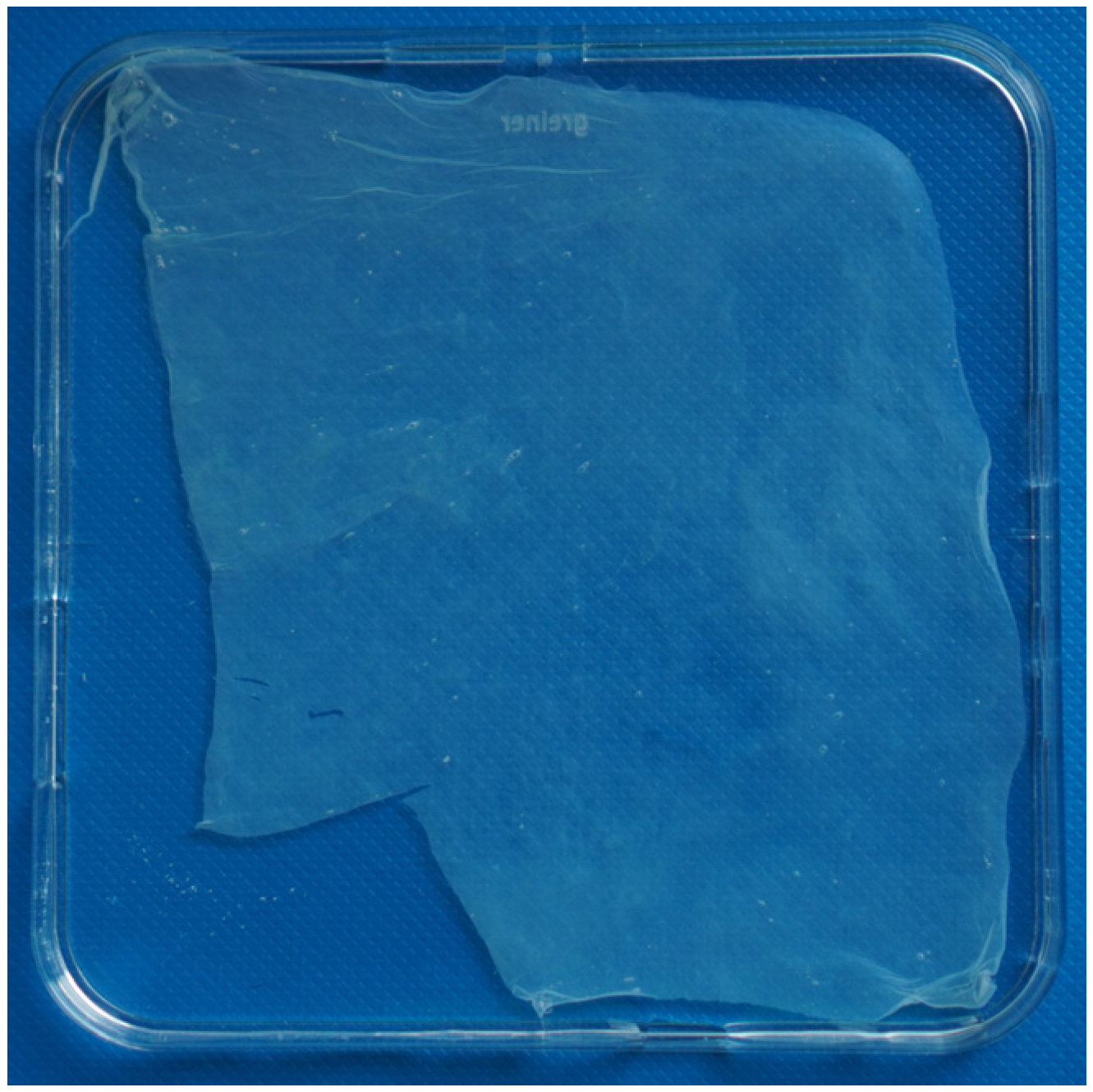
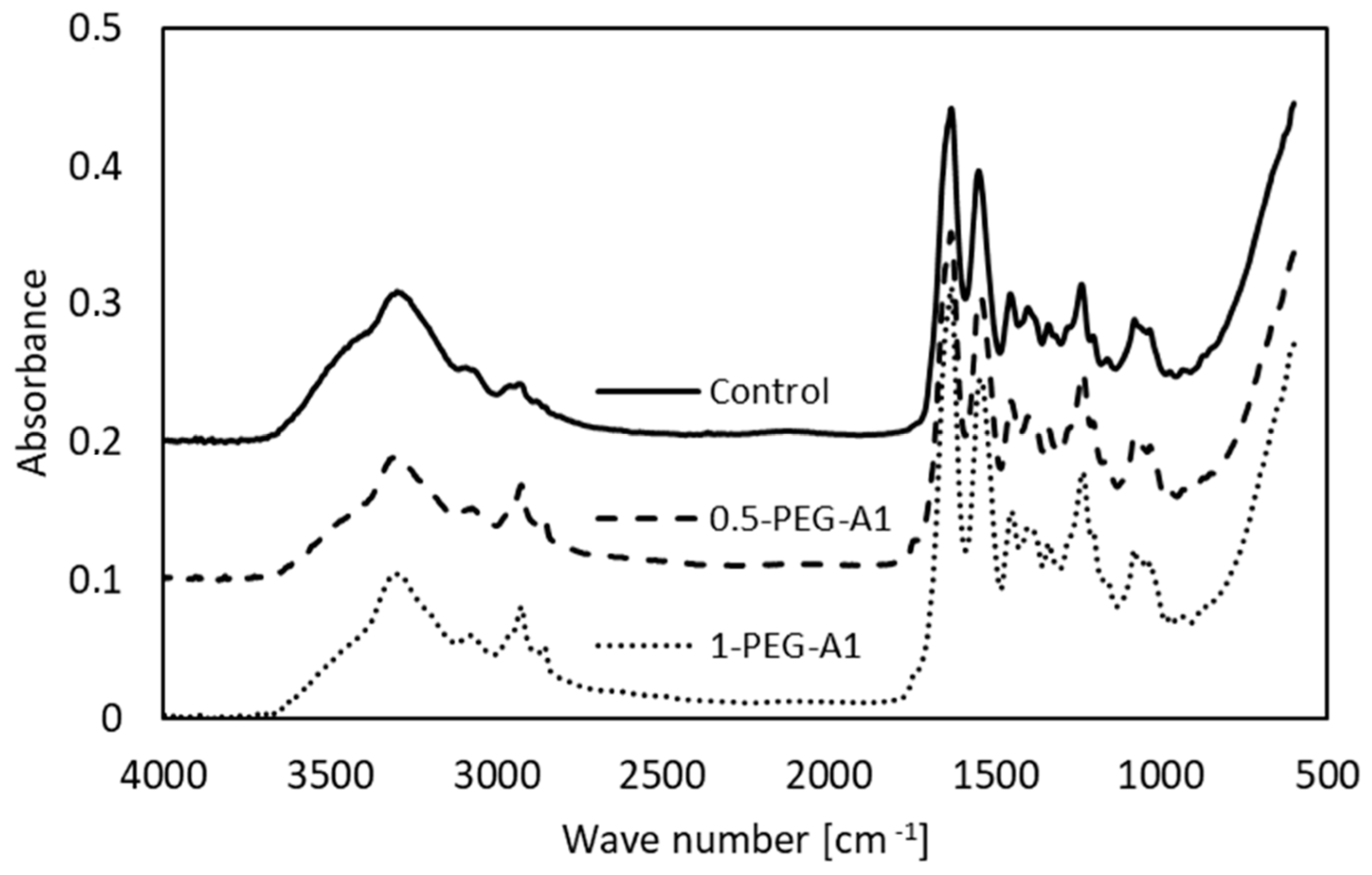
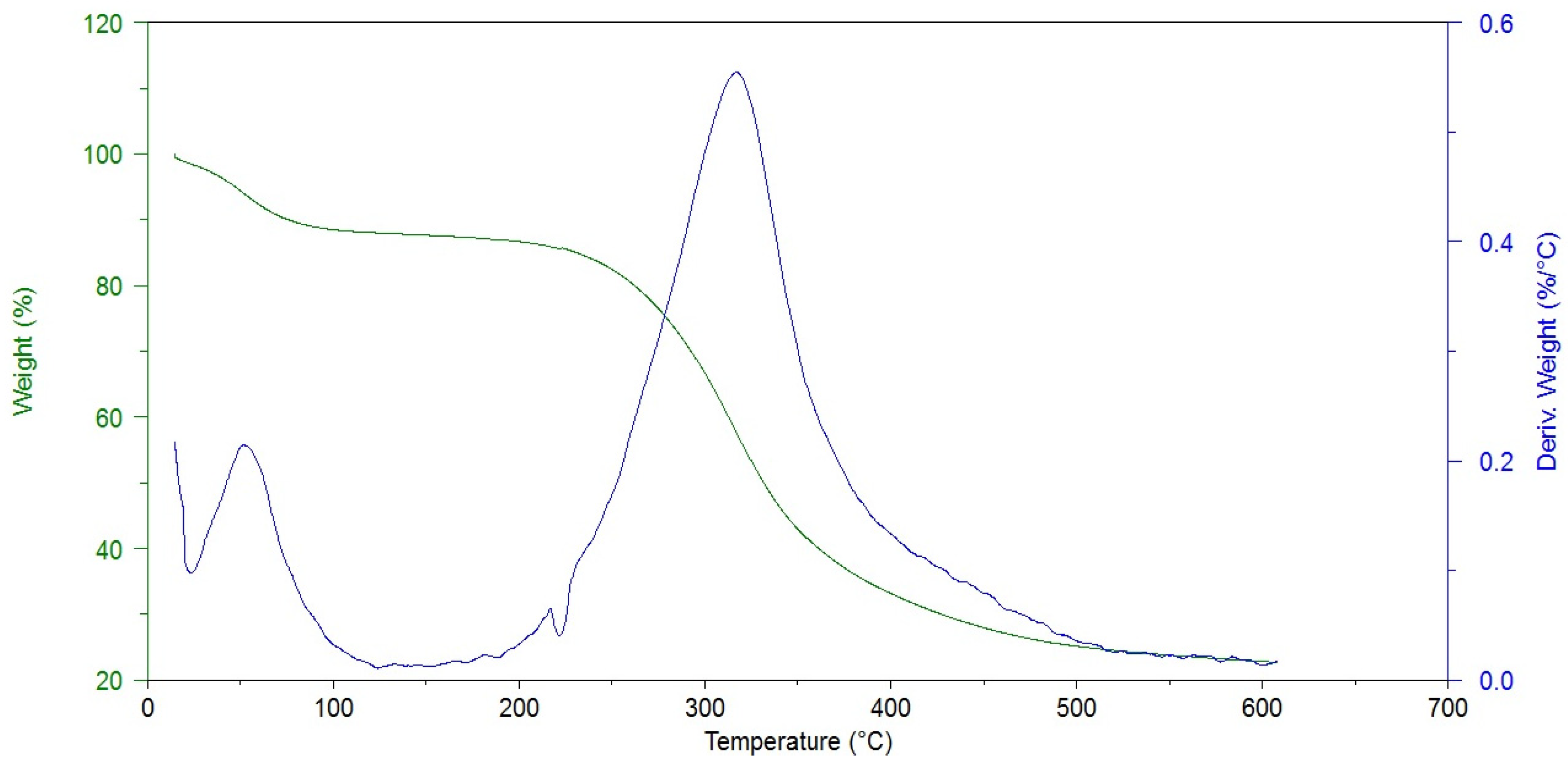

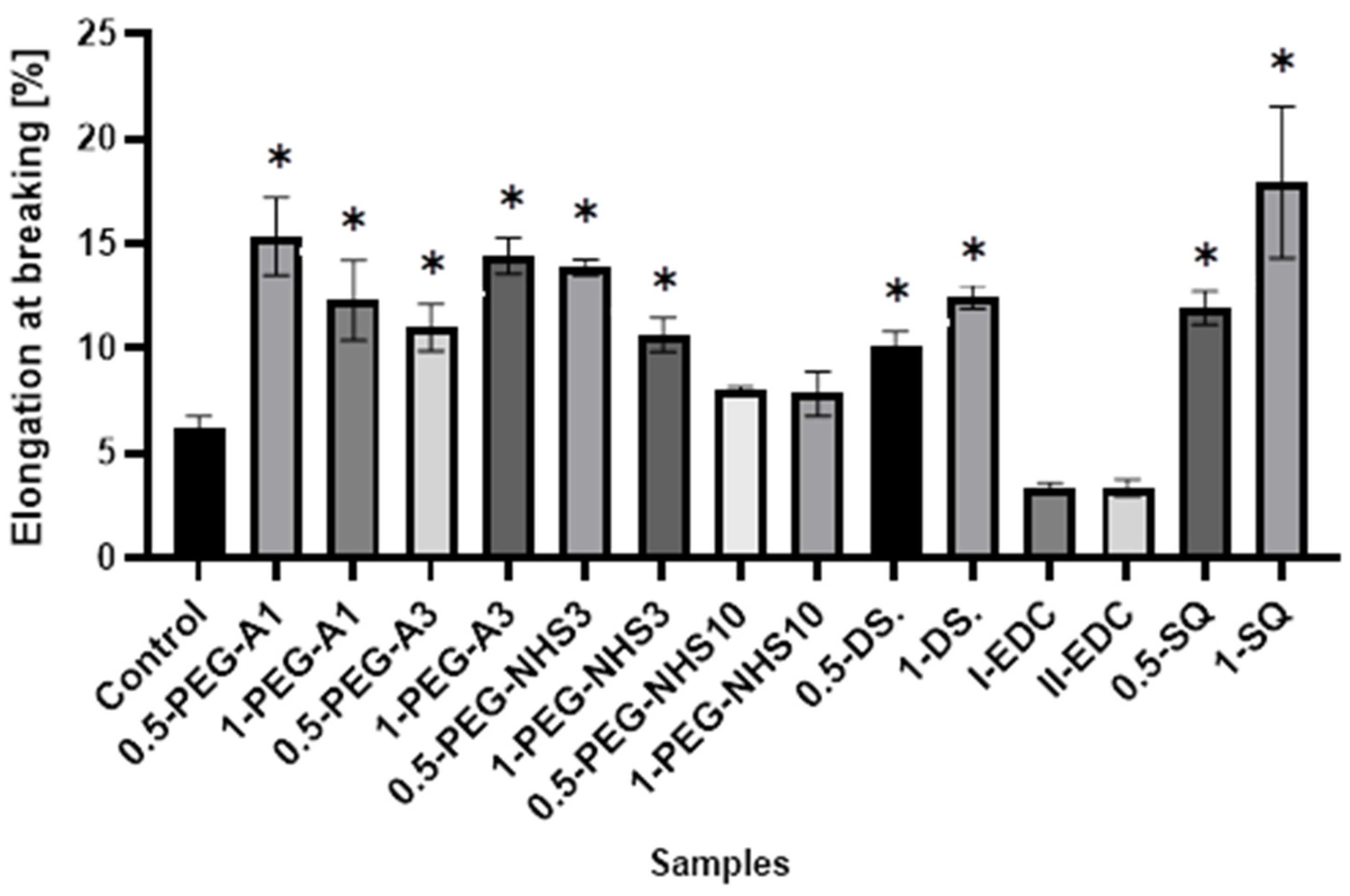
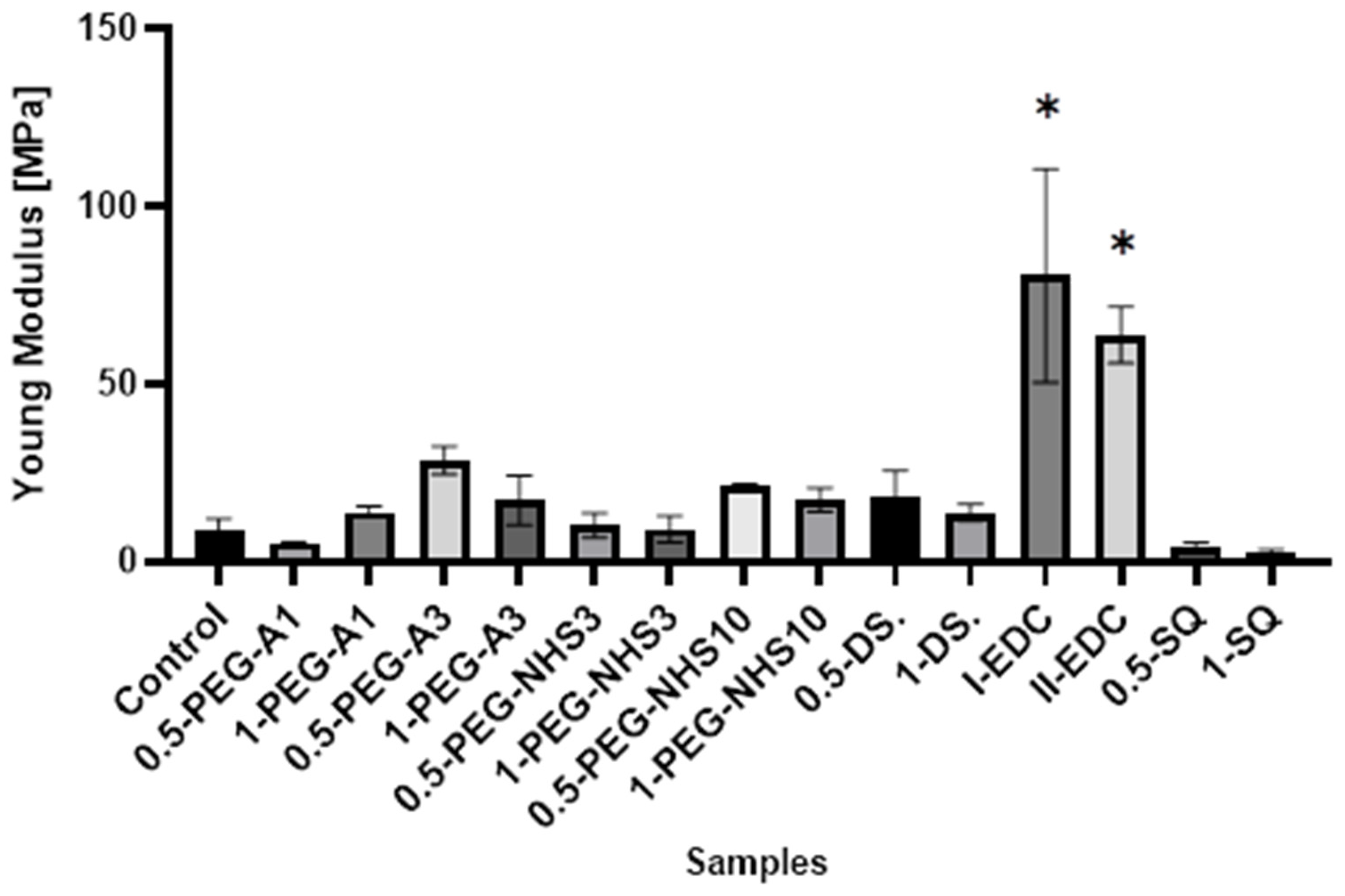
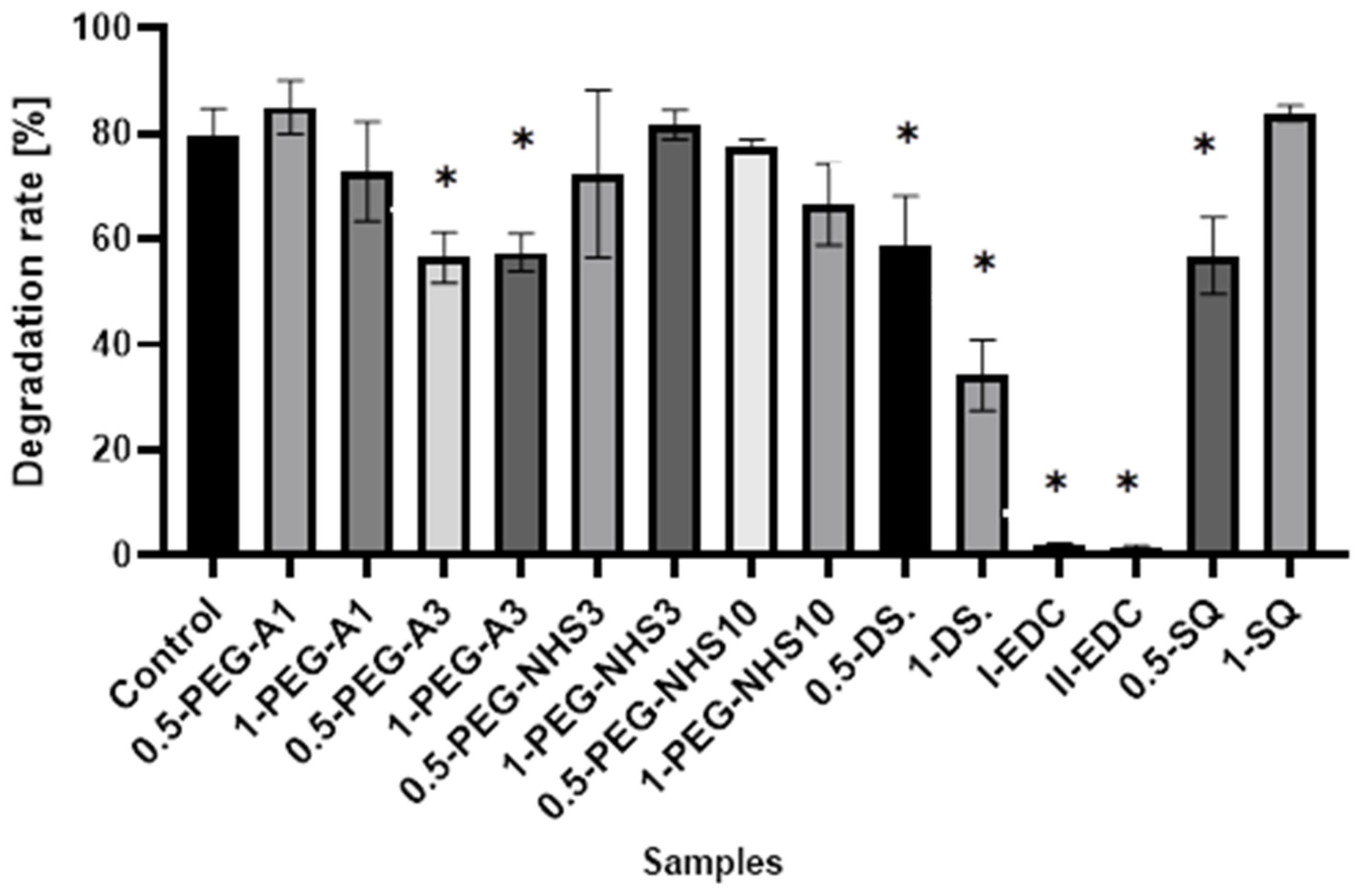
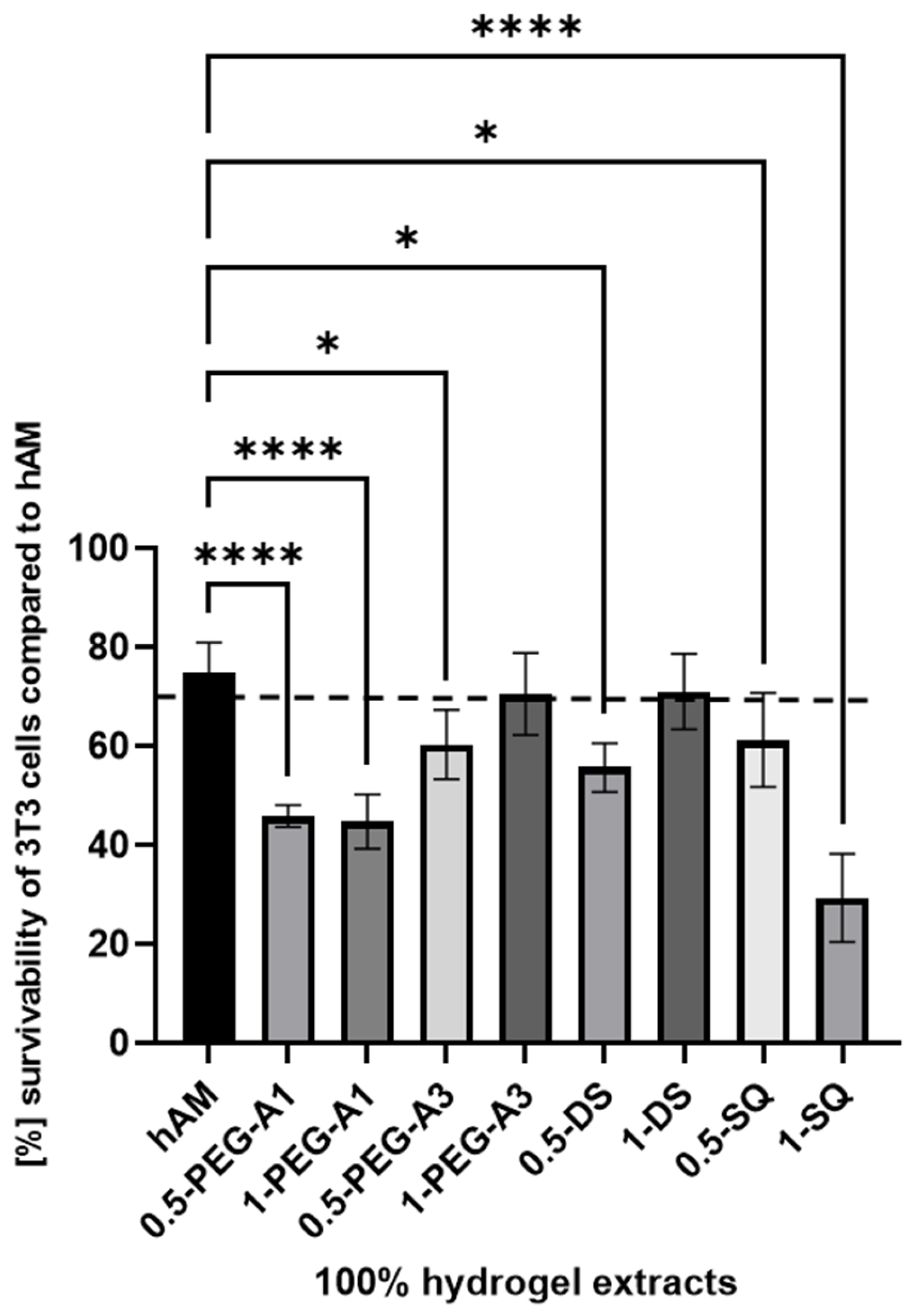
| Sample | Amide A [cm−1] | Amide B [cm−1] | =CH2 [cm−1] | C=O [cm−1] | Amide I [cm−1] | Amide II [cm−1] | Amide III [cm−1] |
|---|---|---|---|---|---|---|---|
| Control | 3298 | 3092 | 2933 | - | 1631 | 1548 | 1239 |
| 0.5-PEG-A1 | 3301 | 3072 | 2925 2854 | - | 1632 | 1544 | 1236 |
| 1-PEG-A1 | 3300 | 3074 | 2925 2854 | 1743 | 1632 | 1542 | 1236 |
| 0.5-PEG-A3 | 3300 | 3074 | 2924 2854 | - | 1632 | 1548 | 1238 |
| 1-PEG-A3 | 3285 | 3062 | 2923 2853 | 1737 | 1647 | 1538 | 1234 |
| 0.5-PEG-NHS3 | 3301 | 3075 | 2924 2854 | - | 1631 | 1549 | 1239 |
| 1-PEG-NHS3 | 3284 | 3072 | 2923 2853 | 1741 | 1645 | 1540 | 1239 |
| 0.5-PEG-NHS10 | 3300 | 3074 | 2926 2854 | - | 1632 | 1538 | 1235 |
| 1-PEG-NHS10 | 3300 | 3074 | 2924 2854 | 1738 | 1631 | 1549 | 1239 |
| 0.5-DS | 3282 | 3063 | 2922 2852 | 1737 | 1651 | 1538 | 1235 |
| 1-DS | 3300 | 3074 | 2926 2854 | 1739 | 1632 | 1548 | 1238 |
| I-EDC | 3298 | 3089 | 2924 2854 | 1745 | 1632 | 1547 | 1238 |
| II-EDC | 3287 | 3073 | 2925 2854 | 1743 | 1632 | 1546 | 1238 |
| 0.5-SQ | 3283 | 3063 | 2922 2853 | 1742 | 1655 | 1538 | 1234 |
| 1-SQ | 3285 | 3075 | 2923 2853 | 1742 | 1645 | 1538 | 1236 |
| Sample | T1 max [°C] | Δm1 [%] | T2 max [°C] | Δm2 [%] |
|---|---|---|---|---|
| Control | 33.6 | 19.70 | 315.4 | 75.91 |
| 0.5-PEG-A1 | 49.9 | 5.71 | 321.1 | 47.50 |
| 1-PEG-A1 | 51.7 | 13.17 | 316.4 | 62.64 |
| 0.5-PEG-A3 | 42.5 | 11.48 | 317.5 | 73.20 |
| 1-PEG-A3 | 49.0 | 11.69 | 319.6 | 62.33 |
| 0.5-PEG-NHS3 | 51.4 | 9.36 | 319.1 | 45.13 |
| 1-PEG-NHS3 | 49.7 | 8.66 | 319.9 | 59.34 |
| 0.5-PEG-NHS10 | 51.2 | 18.09 | 316.5 | 43.15 |
| 1-PEG-NHS10 | 49.7 | 15.29 | 317.8 | 75.38 |
| 0.5-DS | 52.9 | 10.26 | 319.5 | 57.35 |
| 1-DS | 50.0 | 10.49 | 317.1 | 56.85 |
| I-EDC | 53.9 | 18.24 | 318.8 | 65.25 |
| II-EDC | 49.7 | 14.91 | 320.3 | 85.08 |
| 0.5-SQ | 51.7 | 13.83 | 318.5 | 77.46 |
| 1-SQ | 51.9 | 11.65 | 316.8 | 63.85 |
Disclaimer/Publisher’s Note: The statements, opinions and data contained in all publications are solely those of the individual author(s) and contributor(s) and not of MDPI and/or the editor(s). MDPI and/or the editor(s) disclaim responsibility for any injury to people or property resulting from any ideas, methods, instructions or products referred to in the content. |
© 2023 by the authors. Licensee MDPI, Basel, Switzerland. This article is an open access article distributed under the terms and conditions of the Creative Commons Attribution (CC BY) license (https://creativecommons.org/licenses/by/4.0/).
Share and Cite
Skopinska-Wisniewska, J.; Michalak, M.; Tworkiewicz, J.; Tyloch, D.; Tuszynska, M.; Bajek, A. Modification of the Human Amniotic Membrane Using Different Cross-Linking Agents as a Promising Tool for Regenerative Medicine. Materials 2023, 16, 6726. https://doi.org/10.3390/ma16206726
Skopinska-Wisniewska J, Michalak M, Tworkiewicz J, Tyloch D, Tuszynska M, Bajek A. Modification of the Human Amniotic Membrane Using Different Cross-Linking Agents as a Promising Tool for Regenerative Medicine. Materials. 2023; 16(20):6726. https://doi.org/10.3390/ma16206726
Chicago/Turabian StyleSkopinska-Wisniewska, Joanna, Marlena Michalak, Jakub Tworkiewicz, Dominik Tyloch, Marta Tuszynska, and Anna Bajek. 2023. "Modification of the Human Amniotic Membrane Using Different Cross-Linking Agents as a Promising Tool for Regenerative Medicine" Materials 16, no. 20: 6726. https://doi.org/10.3390/ma16206726






